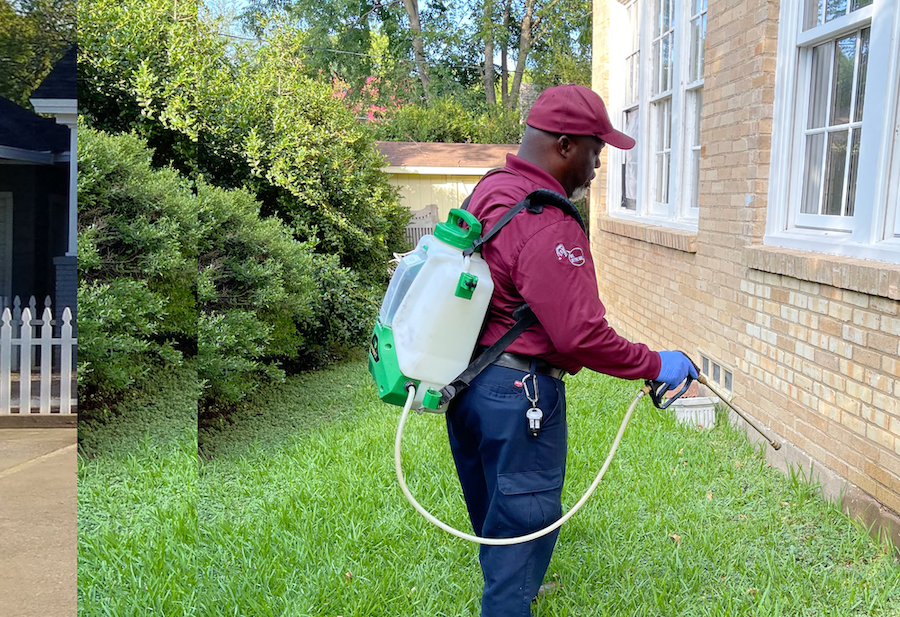Kansas City Pest Control attempts to manage pests so that they cause as little harm as possible. This includes prevention—keeping pests from becoming a problem—suppression—reducing their numbers to an acceptable level—and eradication—destroying them completely.
Physical or mechanical controls include barriers, traps, nets, and netting to prevent birds from damaging fruit crops, nematodes that attack root-rot fungi, and heat treatments for wood-destroying insects.

The best way to deal with pests is to prevent them from invading in the first place. For instance, holes in the floorboards should be repaired before ants or termites can chew their way in, stacks of old newspapers stored in the garage should be recycled before rats shred them for nests, and food should be kept securely sealed in refrigerators. Maintaining buildings and yards clean can also help prevent pests by removing their food, water and shelter sources. For example, trash should be regularly disposed of, and garbage cans should be tightly closed.
Some pests are prevented naturally by the environment, including natural barriers such as mountains and rivers, which limit their ranges; climatic factors that reduce their numbers, such as rain or snow; or other natural conditions such as seasonal variations in temperature or humidity. Other pests are controlled by modifying the environment where they live, such as planting crops that resist damage from insects or using special fertilizers to counteract the negative effects of soil nutrients on some pests.
When prevention measures fail, scouting and monitoring become necessary to identify problems before they spread. This is known as “threshold-based decision making” and involves determining when to take action based on the number of pests and the level of damage they are causing. For instance, a few flies buzzing around the house once in a while doesn’t require any action but a steady stream of flies flying into food preparation areas does warrant treatment.
Suppression and prevention are usually the primary goals of pest control, but eradication is occasionally attempted. This is often done when a pest threatens human health, such as mosquitoes or rodents infesting houses. It is also often a goal of indoor pest control programs in schools, hospitals, offices and food preparation facilities.
Pesticides are effective tools for controlling pests, but they may harm other organisms, such as beneficial insects or wildlife, if used improperly or in the wrong place or at the wrong time. To minimize the chance of this, select the proper control measure for each pest, keep it in the right place and at the correct time, and use enough to achieve the desired result with the least possible risk to humans, property or the environment.
Suppression
The goal of pest control is to reduce or eliminate the damage caused by a particular pest. This is typically achieved by preventing pests from entering or accessing a site, or by reducing their numbers to an acceptable level. Suppression strategies may also include a variety of biological, physical, chemical and cultural controls. This approach is designed to cause as little harm as possible to non-target organisms and the environment.
Preventing pests is the most cost-effective and environmentally sound way to deal with them. This involves eliminating their sources of food, water and shelter. Store food in containers with tight-fitting lids, and remove garbage on a regular basis. Seal and close any cracks or holes that can provide entry points for pests, and regularly inspect the home for problems such as leaking plumbing or overflowing gutters.
Many pests can be controlled without the use of chemical products, including baits, traps and repellents. When pesticides are used, they should be sprayed or dusted at the point of infestation and applied with minimal exposure to people, pets and wildlife. The use of fewer chemicals can also reduce risks of environmental contamination and public health problems.
Biological pest control utilizes natural predators, parasites and disease-causing microorganisms to eliminate pest populations. This method can be effective, but it is also labour intensive and costly, and requires a significant amount of monitoring to ensure that invasive species are not introduced to the area.
Nematodes are microscopic worms that can be used to destroy pests such as grubs, fleas and ants. When the correct species is applied, these tiny nematodes will not only kill their host but will also release toxins into the soil that will prevent future infestations.
Physical and mechanical pest control methods are often used in conjunction with other management practices, such as crop rotation and land management. These help to create healthy and productive soil that is less attractive to pests.
It is important to remember that even with the best of preventive measures, sometimes pests can still become a nuisance or a problem. This is why it is so essential to consider a variety of control options and to keep the bigger picture in mind when making decisions about pest control.
Eradication
Pest control practices are used to eliminate or reduce pest populations. They may involve chemicals, such as insecticides, plant pathogens or herbicides, biological controls or mechanical controls. In some cases, pest control can be accomplished by altering the environment in ways that make it unattractive to the pests (for example, changing water availability). Landlords and property managers should keep in mind that the use of pesticide is regulated under New York State Environmental Conservation Law and should consult with their attorney before applying pesticides on their properties.
Before pests can be controlled, they must be identified. Accurate identification is essential because it provides information about the pest, such as its life cycle and where it occurs. Pesticides are designed to target specific pests and should be applied at the time when the pest is most susceptible. Sometimes pesticide applications fail because the pests are resistant to the chemical. This can happen if the chemical has been used over time or if it is not applied properly.
Biological controls involve using natural enemies to control pests, such as predators and parasites. This type of pest control is usually considered to be environmentally friendly, but it can be expensive and require regular monitoring. Similarly, cultural controls involve changing the environment to make it less attractive to pests. For example, modifying irrigation systems to reduce soil moisture can help control weeds and root diseases.
Mechanical controls include the use of physical barriers to prevent pests from entering buildings or structures and using non-chemical methods to discourage pests. For example, a cockroach-proof sealant can be applied to crevices in walls and cabinets. Adding insulation to attics and walls can also provide pest control, because the cellulose in some brands of insulation has a self-grooming factor that can kill ants, roaches, and termites.
Some people attempt to do their own pest control, such as when they spot a mouse in the garden or an ant’s nest in the house. However, pest management is normally carried out by licensed pest controllers, especially in commercial premises. This can be a local council pest control officer or one of the 878 professional commercial pest control service companies operating in the UK. It is important to remember that pesticides can be harmful to humans and pets, so they should only be used by those who are appropriately trained and have a pesticide applicator’s license. When hiring a pest control company, ask to see their licence and the EPA registration number for the chemical they will be using. Write down this information in case you need to look up more information about the chemical later. It is also wise to check whether the pesticide is registered for use in homes, because not all pesticides are suitable for this purpose.
Monitoring
Keeping records of pest activity is an important part of the monitoring process. Recording pests, their damage, and their behavior on a regular basis can help prevent infestations or detect them at an early stage when they are easier to control. Regular scouting can be done by hand, with a magnifying glass and a clipboard or other tool for recording, or by using commercially available traps and devices such as sticky boards, electronic fly traps and moth pots. In addition, regularly checking for weeds and other undesirable vegetation is also essential. A good scouting practice is to check plants on a weekly basis and be consistent. Look at the undersides of leaves and stem axils, the flower heads, or other tight spaces where insects hide. Tap flowers and plants on a hard surface to see if any bugs escape, or gently drop a pot on a bench to check for insect populations inside.
In many cases, pests in cultural heritage buildings are merely nuisance organisms that don’t cause significant damage, or can be controlled without the use of harsh chemical treatments. However, some pests, such as fungus-eating plaster beetles and psocids in museums, pose a direct threat to collection materials and must be kept at bay.
Monitoring allows pest control practitioners to determine when a threshold has been reached and decide when it is time to begin controlling them. Thresholds are determined by the level of unacceptable damage or injury, and vary depending on the pest and the environment. For example, a few wasps flying around a garden probably don’t warrant pest control action, but several thousand Japanese beetles swarming in a field are an indication that action is needed.
Pest identification is the key to an effective integrated pest management (IPM) program. Accurate identification allows practitioners to distinguish between beneficial organisms, such as biocontrol agents that keep pest populations in check and non-beneficial, harmful or invasive species. In addition, accurate identification can reveal environmental conditions that are conducive to pest growth and help determine the appropriateness of less risky control methods compared to more severe, but still environmentally responsible, treatments such as pesticides.

